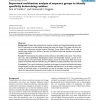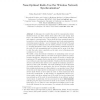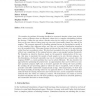55 search results - page 9 / 11 » Could there be exactly two things |
BLISS
2009
IEEE
13 years 8 months ago
2009
IEEE
Self configuring VLSI technology architectures offer a new environment for creating novel security functions. Two such functions for physical security architectures are proposed t...
BMCBI
2007
13 years 7 months ago
2007
Background: Proteins that evolve from a common ancestor can change functionality over time, and it is important to be able identify residues that cause this change. In this paper ...
ALGOSENSORS
2009
Springer
14 years 1 months ago
2009
Springer
In this paper we consider the model of communication where wireless devices can either switch their radios off to save energy (and hence, can neither send nor receive messages), o...
BMCBI
2007
13 years 7 months ago
2007
Background: DNA melting curve analysis using double-stranded DNA-specific dyes such as SYTO9 produce complex and reproducible melting profiles, resulting in the detection of multi...
JMLR
2008
13 years 7 months ago
2008
We consider the problem of learning classifiers in structured domains, where some objects have a subset of features that are inherently absent due to complex relationships between...



